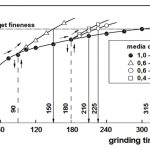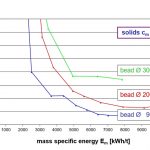Premium inks or functional coatings are produced using a wet grinding process with agitated bead mills. To produce high quality suspensions however, extremely fine dispersing of the functional materials is required. Thanks to the use of micro-grinding beads the Micromedia technology makes possible gentle dispersion in the nanometer range, as well as energy savings of up to 50 %.
Agitated bead mill produces suspensions in the nanometer range
More efficiency thanks to micro-beads
Premium inks or functional coatings are produced using a wet grinding process with agitated bead mills. To produce high quality suspensions however, extremely fine dispersing of the functional materials is required. Thanks to the use of micro-grinding beads the Micromedia technology makes possible gentle dispersion in the nanometer range, as well as energy savings of up to 50 %.
Protective coating as well as high-quality printing inks are produced with a wet grinding technology. In the process, color pigments are crushed and evenly incorporated in a binding material. In the case of colors, this function is only visual. In other applications, however, the surface treatment can be to protect against corrosion or rot or to create conductivity. Bead mills have proven to be particularly efficient for producing liquid to slightly viscous suspensions with relatively small particles. They consist of a cylindrical container that is filled with up to 90 % grinding beads. A special rotor moves the beads into relation with each other to create an effective grinding movement. Due to the constant, physical stress between the beads, the particle agglomerates of color pigment, for example, are broken up, the primary particles are wetted and then dispersed as evenly as possible in a liquid medium.
Advantages of micro-grinding beads
The requirements for the quality of such suspensions have again increased significantly in recent years. Printing inks for food packaging, for instance, need to have a very high colour strength or special coatings that are extremely stable. But there are also new applications in the electronics sector, such as conductive pastes for circuits or colour filters for LC displays, which require even finer and more uniform particle suspensions. To meet this need, Bühler developed the Micromedia process based on proven wet grinding technology. Bead mills of this type allow the manufacturing of suspensions with a particle size of up to just a few nanometers while simultaneously providing an energy savings potential of up to 50 %.
This increased efficiency is possible by using micro-grinding beads which are only between 20 and 800 µm in size. In conventional systems, in comparison, the diameter of the beads is between 0.3 and 1.5 mm. The smaller bead size improves the essential quality feature of a suspension: the particle size distribution. This depends on how efficiently the energy transferred to the solid material can be implemented. In the process, as many mechanical stress events as possible should be caused through the grinding beads. The more beads there are in a given volume of space, the higher the total surface area is and, thus, the more likely there will be contact with the particle agglomerates. As a result, the number of mechanical stress events in a system with Micromedia technology will be much higher in total than compared to conventional grinding systems.
Reduced energy consumption
A higher number of mechanical stress events means that the particle agglomerate is broken up faster. In addition, the bead package needs less acceleration by the rotor in order to achieve the desired intensity for size reduction. This leads to a reduction in energy consumption. To manufacture one ton of suspension, a total of 30 to 50 % fewer kilowatt hours are needed. Using an identical amount of energy, the micro-grinding beads increase productivity while, at the same time, producing up to 30 % more suspension.
Existing customers can also benefit from these advantages: The process zone of an agitated bead mill of the type Superflow or Advantis can be quickly and easily retrofitted to the Micromedia technology with an upgrade package.
Adjusting quality characteristics
The micro-grinding beads allow the production of suspensions with a particle size of just a few nanometers. This is particularly an advantage in the manufacture of high-quality inks for food packaging, amongst others. Thanks to the finer grinding less pigment is required. Because the colour substances are a major cost factor, the manufacturer’s profit margin is directly improved. Fine grinding is also important for technical applications: It improves the stability of colour filters for LC displays and increases conductivity of metal pastes.
In addition to reduced energy consumption, increases in productivity and the higher quality achieved with Micromedia mills, there is also flexibility: Additional quality characteristics besides the particle size distribution – such as colour intensity, glossiness, reactivity, flow properties or durability – can be selectively adjusted depending on the requirements of the final product. Due to the special arrangement of the components, a particularly effective combination of shear, pressure and impact forces affect the functional ingredients. A high proportion of shear, which stresses the particles by moving the liquid, makes a gentle and fine dispersion possible. The process window of Micromedia technology is very large and ranges from gentle dispersion in the nanometer range up to energy-intensive, true grinding. This allows manufacturing a wide range of end products.
Depending on the application, the process zone will be equipped with various materials which are abrasion-resistant, corrosion-resistant or free of metal. For normal pigment dispersion, for example, a simple steel lining is recommended. It is cost-effective, offers a good cooling performance and has a long service life. For producing ceramic inkjet inks, in contrast, extremely hard pigments are processed which could lead to abrasion in a steel version. In this case, a combination of a ceramic stator and a polyamide rotor is ideal. When the materials are optimally coordinated to the individual process, the service life of the components is increased and downtimes are avoided. This also helps to increase productivity and improve cost effectiveness.
www.cpp-net.com search: cpp0216bühler
BU:
Rotor of the Micromedia mill. Depending on the application, different materials can be chosen for the process zone
Reduction of grinding time by reduces bead diameter
Sectional view of the Micromedia mill: Switching to smaller grinding beads can achieve specific fineness more quickly and more energy-efficiently.
The smaller the grinding beads, the finer the achievable particle size in suspensions
Norbert Kern
Norbert Kern
Head of Process Engineering, Business Area Grinding & Dispersion Technologies, Bühler
Share:








